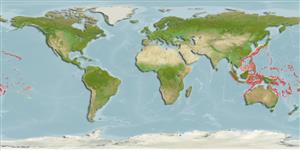Preferred temperature (Ref.
123201): 12.9 - 21.1, mean 16.3 °C (based on 59 cells).
Phylogenetic diversity index (Ref.
82804): PD
50 = 0.5000 [Uniqueness, from 0.5 = low to 2.0 = high].
Bayesian length-weight: a=0.01259 (0.00606 - 0.02615), b=3.03 (2.86 - 3.20), in cm total length, based on LWR estimates for this (Sub)family-body shape (Ref.
93245).
ระดับชั้นอาหาร (Ref.
69278): 3.6 ±0.5 se; based on size and trophs of closest relatives
ความสามารถในการกลับคืนสู่ปกติ (Ref.
120179): ต่ำ, เวลาต่ำสุดที่จะทำให้ประชากรเพิ่มขึ้นเป็น 2 เท่าใช้เวลา 4.5 - 14 ปี (Preliminary K or Fecundity.).
Fishing Vulnerability (Ref.
59153): Low to moderate vulnerability (35 of 100).
Nutrients (Ref.
124155): Calcium = 118 [62, 274] mg/100g; Iron = 1.03 [0.53, 2.14] mg/100g; Protein = 17.4 [15.6, 19.3] %; Omega3 = 0.377 [0.160, 1.048] g/100g; Selenium = 69.4 [33.5, 187.6] μg/100g; VitaminA = 30.1 [9.9, 90.0] μg/100g; Zinc = 1.2 [0.8, 1.8] mg/100g (wet weight);
